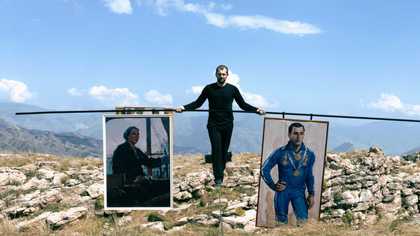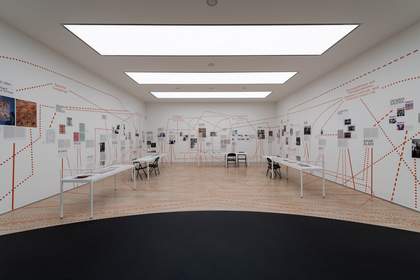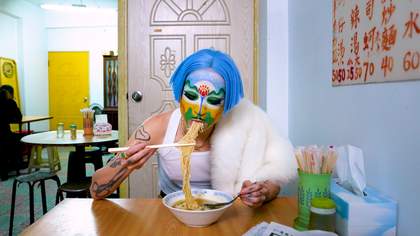The international conference ‘Multiple Histories and Transnational Narratives: Re-Orienting European Museums’ was organised and funded by the Hyundai Tate Research Centre: Transnational in partnership with the research programme on Art and Globalisation led by Zahia Rahmani at INHA. Held in French and English, the conference featured talks from academics and curators working across Europe, as well as from two artists whose work confronts the legacies of colonialism and their narratives. Incidentally, on the same day as the event, a press conference in Berlin announced definitive steps towards the repatriation to Nigeria of a collection of Benin bronzes currently held in Germany. While the restitution of artefacts looted during European colonialism was not a central theme of the conference, the news certainly resonated with many of the ideas raised during the day.
The two main objectives of the conference were to analyse the engagement of European museums with decolonial theory and practice using a variety of case studies and, importantly, to propose potential new directions in museum practices. As a counterpoint to historical and institutional debates, and in a move prompted by recent feedback and research, the organisers invited artists Taus Makhacheva and Kader Attia to present on their current artistic practice and concerns. Their inclusion in the programme was significant in that it highlighted the impact that contemporary artistic practice can have on the formulation of narratives and discourses – and vice-versa. In this way, the conference allowed for the charting of concrete paths of action to tackle some of today’s most pressing cultural issues, while also articulating them in their full complexity and nuance.

Taus Makhacheva
Tightrope 2015
Video, high definition, projection, colour and sound (stereo)
Duration: 58 min, 10 sec
Tate
© Taus Makhacheva
Most of the talks began from a similar starting point: by acknowledging the fundamental need for a ‘rebalancing’ of the stories we tell. This was stated by Tate curator Sook-Kyung Lee in her introductory comments and later echoed in Makhacheva’s work, in pieces like the 2015 video Tightrope.1 Another key issue across the talks was the multiple ways in which the colonial past survives today. This was the central focus of the contribution from Attia, a visual artist and the guest curator of the 2022 Berlin Biennale, who joined remotely from Germany to be in conversation with Devika Singh (Tate). In addition, the need for a civic art history, attentive to the present and capable of confronting urgent social issues head-on, was raised by Éric de Chassey from INHA. This was echoed in the opening remarks by the convenors Rahmani, Lee and Singh, and was conveyed from various perspectives across the three successive panel discussions.
The first of these panels, ‘Re-imagining Modernities’, moderated by Natalia Sidlina from Tate, addressed the question of decentring art history and confronting its blind spots. The second, ‘Re-thinking the Role of Museums’, directed the audience’s attention to a series of museographic experiments which invoked the polyphonic stories of the lives of objects as well as their pluralistic values. Finally, ‘Contemporary Narratives’ drew together a series of reflections on museum traditions and the potential for new curatorial approaches. At the close of each session, the audience was given the opportunity to engage with the contributors in discussion, though this part was regrettably brief.
Several speakers examined the ideological and political inner workings of European museums in recent decades. By remarking on the propensity of museums to ‘emulate their own image’, Eva-Maria Troelenberg (Heinrich Heine University, Düsseldorf) summarised and critically considered the opening of the Humboldt Forum on Berlin’s Museum Island in 2020. She then turned her attention to the inherent tensions in the move to decolonise museums. It is worth noting that the term ‘decolonisation’ was itself subject to criticism during the discussions, in particular for its situatedness. For some, the use of this term risks re-centring European museums at the expense of other actors’ agency, relegating them to a role deemed too passive. The conference allowed the participants to reflect on areas of art history which are often neglected as a result of conscious or unconscious academic and institutional inclinations.
In his talk, Pierre Singaravélou (University of Paris 1 Panthéon-Sorbonne and King’s College London) presented a more methodical approach to the objects held in French national collections, seeking to uncover a history that is global, more equitable, and forged from ‘hybridities’ and ‘contradictions’. While efforts such as these have been shaping art history for several decades now, their greater prominence and the increased funding behind them were also a subject of discussion. At the core of Philippe Dagen’s (University of Paris 1 Panthéon-Sorbonne) contribution was the racism that has structured modernist artistic narratives: his talk centred on the Mexican critic and artist Marius de Zayas (1880–1961), whose degrading remarks on the peoples of Africa were quoted with disturbing insistence. The presentation explored de Zayas’s writings and historiography’s failure to deal with him critically, which served as a reminder that the avant-garde’s promotion of so-called ‘African’ arts easily went hand in hand with an unflinching racism.
The contribution from Marie-Laure Allain Bonilla (HEAD, Geneva and HES-SO) offered a transition between the intentions underpinning the conference, namely the analysis of problematic discursive and intellectual legacies, and a contemporary observation: that of a significant epistemological shift in academic and museum-related concerns. Her talk traced the history of a notably timid confrontation: that of Switzerland with Europe’s colonial past, which Swiss institutions have traditionally – and mistakenly – considered ‘distant’ from their country’s own history. Allain Bonilla discussed the work of historian Patricia Purtschert, and the exhibition Une Suisse exotique? (‘Exotic Switzerland?’) at the Palais de Rumine in Lausanne in 2020, both of which were unprecedented in their treatment of Swiss history.2 It was precisely in examining the ‘device’ of the temporary exhibition, as well as through the attention paid to the importance of how collections are arranged and hung, that the conference proved to be most forward-looking.

Group Dynamics: Collectives of the Modernist Period, installation view, Lenbachhaus, Munich, 2021
Photo: Simone Gänsheimer
By reiterating the need for an alternative, interwoven, pluralist and transnational approach to modernism, Matthias Mühling, director of the Lenbachhaus in Munich, discussed the work conducted on the historiography of modern art in the Lenbachhaus’s recent exhibition Group Dynamics: Collectives of the Modernist Period (2021). Mühling called for genuine, deep and lasting partnerships between international museums. Annabelle Ténèze (Les Abattoirs, Musée – Frac Occitanie Toulouse) picked up the thread of this collective desire for institutional deconstruction and ‘opening up’ by discussing a range of exhibition projects recently presented at Les Abattoirs in Toulouse. Reflecting the drive to expand the social and political role of the museum, the talk represented an effort to make explicit the modalities of production of seeing and knowing. Ténèze sought to situate these discourses and reveal their various implications, but also to consider with greater vigour the institution’s place in local life and its relationship with the public.

Sin Wai Kin fka Victoria Sin
A Dream of Wholeness in Parts 2021
Single-channel video, 4k, colour, sound
Duration: 23 min, 3 sec
© The artist. Courtesy the artist, Chi-Wen Gallery, Taipei and Soft Opening, London. Produced by Chi-Wen Productions
In direct response to these concerns – to ideas regarding the ‘cartography’ of audiences in historical and contemporary art scenes, as well as to collections themselves – Hammad Nasar (Paul Mellon Centre, London and Herbert Art Gallery and Museum, Coventry) spoke about two recent exhibitions. The first, Speech Acts: Reflection-Imagination-Repetition (2018–19) at Manchester Art Gallery, was curated by Nasar and Kate Jesson. This show contrasted so-called ‘highlights’ of public collections with other, lesser-known works often relegated to storage. The second exhibition discussed was British Art Show 9 (2021–2), co-organised by Nasar and Irene Aristizábal, which was shown simultaneously across the UK in Aberdeen, Wolverhampton, Manchester and Plymouth. It included works by artists who directly confront contemporary social and racial tensions, such as Sin Wai Kin, and advocated for a plural understanding of diversity. Proposing alternative geographies and a change in the relationship between the global and the local, Nasar also explained his circumspection towards the hegemony of certain institutions, including Tate. In response, Singh was keen to remind the audience of the work undertaken by teams at various European institutions across the domains of academic research, programming and acquisition strategies.
By platforming the voices of museum staff as well as the critics of these institutions (artists included), the wide-ranging discussions held at this conference ultimately formed a kind of challenge to museum authority. In addition to being a reminder of the importance of museums’ social role, many of the contributions called for greater transparency in the ways in which art is historicised and displayed to the public, as well as in the structural power dynamics of museum management. Makhacheva alluded to this in her description of one of her works in progress, Museum Game. This consists of a card game in which participants ironically take on the role of cultural actors and experience their own agency through this simulation.
While the conference centred on ‘European’ museums and their narratives, the organisers effectively used a self-reflexive approach to respond to certain criticisms and explain their ways of working. Nevertheless, the variety of counter-narratives could have been expanded further. In doing so, the question of the public in all its plurality would have benefitted from a more detailed consideration – a subject which was raised several times during the moments of exchange, as was the issue of the museum as an echo chamber. A more horizontal approach to cultural offerings can open up potentially powerful dialogues by ensuring more diversity in audiences, encouraging their active participation in events, and by expanding the range of programmes offered.
Nevertheless, the day roundly demonstrated the genuine motivation of a group of museum actors advocating for the perpetual reinvention of museum practices. This, they argued, can be achieved through experimentation and risk-taking, based on an ever more nuanced understanding of the weight of history which is always in service of the present. Far from drawing concrete conclusions or providing definitive answers, this rich and expansive day of dialogue helped demonstrate the extent and necessity of the work still to come.
